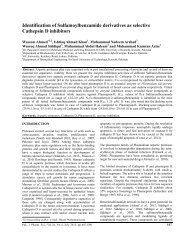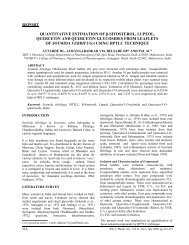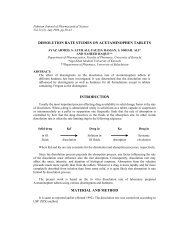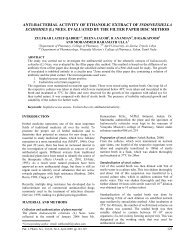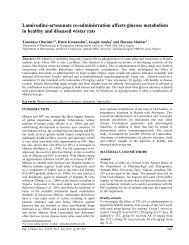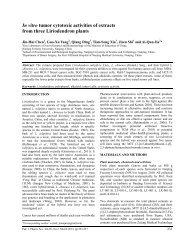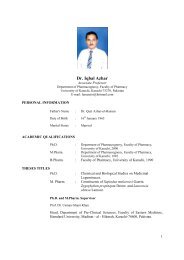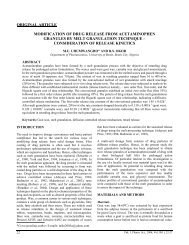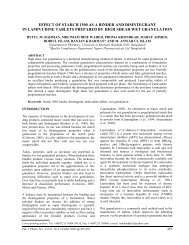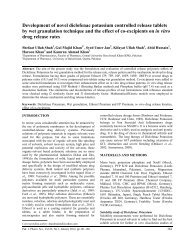original article determination of the ascorbic acid content - Pakistan ...
original article determination of the ascorbic acid content - Pakistan ...
original article determination of the ascorbic acid content - Pakistan ...
You also want an ePaper? Increase the reach of your titles
YUMPU automatically turns print PDFs into web optimized ePapers that Google loves.
Reactions <strong>of</strong> phthalimides with 1-methylethylamine<br />
cefepime and amikacin in humans. Antimicrob. Ag.<br />
Chemo<strong>the</strong>r., 36: 1382-6.<br />
Bertran MA, Bruckner DA and Young LS (1984). In vitro<br />
activity <strong>of</strong> HR 810, a new cephalosporin. Antimicrob.<br />
Agents Cemo<strong>the</strong>r., 26: 277-279.<br />
Ip M, Au C, Cheung SW, Chan CY and Cheng AFB (1998).<br />
A rapid high-performance liquid chromatographic assay<br />
for cefepime, cefpirome and meropenem. J. Antimicrob.<br />
Chemo<strong>the</strong>r., 42(1): 121-123.<br />
Jones RN, Thornsberry C, Barry AL, Ayers L, Brown S,<br />
Daniel J, Fuchs PC, T.L.Gavan TL, Geriach EH, Mastsen<br />
JM, Reller LB and Sommers HM (1984). Disk diffusion<br />
testing, quality control guidelines, and antimicrobial<br />
spectrum <strong>of</strong> HR 810, a fourth-generation cephalosporin,<br />
in clinical microbiology laboratories. J. Clin. Microbiol.,<br />
20: 409-412.<br />
Maass L, Malerczyk V, Verho M, Hajdu P, Seeger K and<br />
Klesel N (1987). Dose linearity testing <strong>of</strong> intravenous<br />
cefpirome (HR 810), a novel cephalosporin derivative.<br />
Infection, 15: 202-206.<br />
Maass L, Malerezyk V and Verho M (1987).<br />
Pharmacokinetics <strong>of</strong> cefpirome (HR 810), a new<br />
cephalosporin derivative administered intramuscularly<br />
ORIGINAL ARTICLE<br />
44<br />
and intravenously to healthy volunteers. Infection, 15:<br />
207-210.<br />
Malerczyk V, Maass L, Verho M, Hajdu P, Klesel N and<br />
Rangoonwala R (1987). Single and multiple dose<br />
pharmacokinetics <strong>of</strong> intravenous cefpirome (HR 810), a<br />
novel cephalosporin derivative. Infection, 15: 211-214.<br />
Seibert G, Limbert M, Winkler I and Dick T (1983). The<br />
antibacterial activity “in-vitro” and β-lactamase stability<br />
<strong>of</strong> <strong>the</strong> new cephalosporin HR 810 in comparison with<br />
five o<strong>the</strong>r cephalosporins and two aminogycosides.<br />
Infection, 11: 275-279.<br />
Sultana N, Arayne MS and Afzal M (2005). Syn<strong>the</strong>sis and<br />
Antibacterial Activity <strong>of</strong> Cephradine Metal Complexes:<br />
Part II Complexes with Cobalt, Copper, Zinc and<br />
Cadmium. Pak. J. Pharm. Sci., 18(1): 36-42.<br />
Sugioka T, Asano T, Chikaraishi Y, Suuki E, Sano A,<br />
Kuriki T, Shirotsuka M and Saito K (1990). Stability and<br />
degradation pattern <strong>of</strong> cefpirome (HR810) in aqueous<br />
solution. Chem. Pharm. Bull., 38 (7): 1998-2000.<br />
Wilson and Gisvold’s Textbook <strong>of</strong> Organic Medicinal and<br />
Pharmaceutical Chemistry, 11 th edition, 2004, pp.332-<br />
333.<br />
Received: 26-1-2006 – Accepted: 28-2-2006<br />
DETERMINATION OF THE ASCORBIC ACID CONTENT<br />
OF TWO MEDICINAL PLANTS IN NIGERIA<br />
OKERI H.A.* AND ALONGE P.O.<br />
Department <strong>of</strong> Pharmaceutical Chemistry,<br />
Faculty <strong>of</strong> Pharmacy, University <strong>of</strong> Benin, Benin City, Nigeria<br />
ABSTRACT<br />
The fresh and dried leaves <strong>of</strong> two edible plants, Oldenlandia corymbosa and Dissotis rotundifolia have been assayed<br />
for <strong>the</strong>ir <strong>ascorbic</strong> <strong>acid</strong> <strong>content</strong>. They were found to be rich sources <strong>of</strong> <strong>ascorbic</strong> <strong>acid</strong> (vitamin C) when compared<br />
with some common garden fruits and vegetables.<br />
Students’ t-test statistical analysis using INSTAT.EXE program for <strong>the</strong> results (mean ± SEM) shows that <strong>the</strong>re was<br />
no significant difference for <strong>the</strong> fresh leaves <strong>of</strong> <strong>the</strong> individual plants and also <strong>the</strong>re is no significant difference for <strong>the</strong><br />
dried leaves (P = 0.05). However, <strong>the</strong>re was significant difference between <strong>ascorbic</strong> <strong>acid</strong> <strong>content</strong> <strong>of</strong> <strong>the</strong> fresh and<br />
dried leaves <strong>of</strong> <strong>the</strong> same plant, obviously indicating that <strong>the</strong> fresh leaves contain more <strong>ascorbic</strong> <strong>acid</strong> than <strong>the</strong> dried<br />
leaves.<br />
Keywords: Ascorbic <strong>acid</strong> <strong>content</strong>, Oldenlandia corymbosa (Linn), Dissotis rotundifolia (SM) Triana, 2,6dichlorophenolindophenol<br />
and Iodimetric <strong>determination</strong>s.<br />
Corresponding author: hokeri1@yahoo.com +23408023112394<br />
Pak. J. Pharm. Sci., 2006, Vol.19(1), 39-44
INTRODUCTION<br />
There is a renewed awareness <strong>of</strong> <strong>the</strong> value <strong>of</strong> natural<br />
resources, and this utilization has led to experimentation <strong>of</strong><br />
plants as food and medicinal supplements. These plants<br />
could be useful components <strong>of</strong> <strong>the</strong> diet, especially for rural<br />
families since <strong>the</strong> plant is found in abundance and collection<br />
for food would be a relatively easy task.<br />
In both plant and animal kingdoms, glucoronic <strong>acid</strong> is<br />
converted to <strong>ascorbic</strong> <strong>acid</strong>, but man, primates and guinea<br />
pigs are unable to bring about <strong>the</strong> conversion <strong>of</strong> Lgulonolactone<br />
to 2-keto-L-gulonolactone which is <strong>the</strong> last<br />
step in <strong>the</strong> syn<strong>the</strong>sis <strong>of</strong> <strong>ascorbic</strong> <strong>acid</strong> (Stenlake, 1979).<br />
Ascorbic <strong>acid</strong> is essential for <strong>the</strong> normal function <strong>of</strong> living<br />
cells and many enzymatic reactions in humans. (Marcus et.<br />
al, 2000; Gersh<strong>of</strong>f, 1979; American Pharmaceutical<br />
Association, 1979) and is obtained from dietary sources<br />
(such as vegetables and fruits) and syn<strong>the</strong>tic vitamin C.<br />
Vitamin C deficiency typically causes abnormalities in<br />
bones, teeth and scurvy. Apart from its role in nutrition,<br />
<strong>ascorbic</strong> <strong>acid</strong> acts as an antioxidant to protect <strong>the</strong> natural<br />
flavour and colour <strong>of</strong> many foods (Barbara, 1984; Williams,<br />
1989). Ascorbic <strong>acid</strong> is a powerful reducing agent that is<br />
readily oxidized in solution, so that <strong>the</strong> natural vitamin is<br />
<strong>of</strong>ten destroyed in <strong>the</strong> cooking and freezing <strong>of</strong> fruits and<br />
vegetables (Williams, 1989).<br />
In this present study, <strong>the</strong> <strong>ascorbic</strong> <strong>acid</strong> <strong>content</strong> was<br />
determined titrimetrically using iodine (Olson and Hodges,<br />
1987) and 2,6-dihydrophenolindophenol (Association <strong>of</strong><br />
Official Analytical Chemists, 1984) solutions. These two<br />
analytical methods were employed for <strong>the</strong> purpose <strong>of</strong><br />
comparison.<br />
This work seeks to establish that <strong>the</strong> <strong>ascorbic</strong> <strong>acid</strong> <strong>content</strong> <strong>of</strong><br />
Oldenlandia corymbosa (Linn) and Dissotis rotundifolia<br />
(SM) Triana are vital for <strong>the</strong> activity <strong>of</strong> <strong>the</strong> plant extracts,<br />
especially its antioxidant effect and that it could be<br />
responsible for <strong>the</strong> traditional usage or at least influence <strong>the</strong><br />
bioavailability <strong>of</strong> active principles <strong>of</strong> <strong>the</strong> plant (Okeri et al,<br />
2004).<br />
Oldenlandia corymbosa (Linn) is a diffusely branched<br />
annual herb used in African folk medicine as an oral<br />
oxytoxic agent (Olaniyi et al, 1973) for snake bite. The<br />
decoction has also been given during labour to induce strong<br />
uterine contractions and short delivery time. The plant has<br />
also been used in treatment <strong>of</strong> intermittent fever and is<br />
recommended against nervous depression (Gill, 1992).<br />
Oldenlandia corymbosa (Linn) is known to also contain<br />
pentacyclic tritepene boswellic <strong>acid</strong> and o<strong>the</strong>r constituents<br />
have been characterized (Olaniyi and Ramstad, 1979).<br />
Okeri and Alonge<br />
On <strong>the</strong> o<strong>the</strong>r hand, Dissotis rotundifolia (SM) Triana is a<br />
pink-purple creeping herb that is easily cultivated in pots<br />
and have been used in African traditional medicine for <strong>the</strong><br />
treatment <strong>of</strong> cough, bronchitis, sinusitis, conjunctivitis,<br />
circulatory troubles, rheumatism, venereal disease, painful<br />
swelling and healing <strong>of</strong> wounds (Dalziel, 1948; Oliver,<br />
1959).<br />
Since foods and vegetables are among <strong>the</strong> most common<br />
consumer items that are regularly taken, it would <strong>the</strong>refore<br />
be useful to analyze some <strong>of</strong> <strong>the</strong>se to determine <strong>the</strong>ir<br />
vitamin C <strong>content</strong> and show <strong>the</strong> relationship between it and<br />
<strong>the</strong>ir traditional usage.<br />
MATERIALS AND METHODS<br />
Materials<br />
Analytical grades <strong>of</strong> 2,6-dichlorophenolindophenol, glacial<br />
acetic <strong>acid</strong>, potassium iodate, potassium iodide, sodium<br />
thiosulphate pentahydrate, oxalic <strong>acid</strong>, sodium citrate,<br />
soluble starch, metaphosphoric <strong>acid</strong> and sulphuric <strong>acid</strong>, all<br />
<strong>of</strong> BDH England were obtained; l-<strong>ascorbic</strong> <strong>acid</strong> (Merck,<br />
Germany), starch (May & Baker, UK) were also obtained as<br />
well as powdered charcoal, deionised water and carbon<br />
dioxide-free distilled water from Chemistry Department,<br />
University <strong>of</strong> Benin.<br />
Oldenlandia corymbosa (Linn) (Rubiaceae) and Dissotis<br />
rotundifolia (SM) Triana (Melastomataceae) as identified<br />
and au<strong>the</strong>nticated by a Dr Abere, Pharmacognosy<br />
Department, University <strong>of</strong> Benin, Benin City, were<br />
collected in October 2003 at <strong>the</strong> University <strong>of</strong> Benin,<br />
Ugbowo campus, Benin City, Nigeria.<br />
Method<br />
Preparation <strong>of</strong> reagents<br />
a For iodimetry 5% starch mucilage indicator and 0.07M <strong>of</strong><br />
sodium thiosulphate pentahydrate solutions were prepared<br />
and <strong>the</strong> later was standardized using 50ml <strong>of</strong> 0.01M pure<br />
potassium iodate containing 2g <strong>of</strong> solid potassium iodide.<br />
0.05M iodine solution was in turn standardized with <strong>the</strong><br />
0.07M standard sodium thiosulphate solution.<br />
0.05M H2SO4 (28ml <strong>of</strong> concentrated sulphuric <strong>acid</strong> diluted<br />
to 1litre) and 0.03M H2SO4 (17ml <strong>of</strong> concentrated sulphuric<br />
<strong>acid</strong> diluted to 1litre) were also prepared.<br />
b For indophenol method a 3.4moles/litre solution <strong>of</strong> 2,6dichlorophenolindophenol<br />
sodium solution was prepared.<br />
5ml <strong>of</strong> <strong>the</strong> above solution was <strong>the</strong>n diluted to 50ml with<br />
deionised water warmed, filtered into an amber-coloured<br />
bottle and <strong>the</strong>n standardized with 0.8mg/100ml <strong>ascorbic</strong><br />
<strong>acid</strong> dissolved in metaphosphoric acetic <strong>acid</strong>.<br />
Pak. J. Pharm. Sci., 2006, Vol.19(1), 44-48 45
Determination <strong>of</strong> <strong>the</strong> <strong>ascorbic</strong> <strong>acid</strong> <strong>content</strong><br />
Metaphosphoric acetic <strong>acid</strong> (0.38moles/litre) was prepared<br />
by dissolving 3g reagent grade metaphosphoric <strong>acid</strong><br />
containing 35% HPO3 in 10ml <strong>of</strong> 5% glacial acetic <strong>acid</strong> and<br />
adding water to make 100ml.<br />
Plant treatment<br />
Parts <strong>of</strong> <strong>the</strong> plants suitable and most desirable for human<br />
consumption were sun-dried for one month and fresh ones<br />
were also obtained. This consisted <strong>of</strong> young, tender parts<br />
while discarding discoloured and insect-damaged portions.<br />
Most <strong>of</strong> <strong>the</strong> samples were collected just prior to or during<br />
<strong>the</strong> flowering period, because it was expected that <strong>the</strong><br />
vitamin <strong>content</strong> would be at its highest level at that time<br />
(Zennie and Ogzewalla, 1977). All plants were collected<br />
within a 20 kilometer radius at <strong>the</strong> Ugbowo campus <strong>of</strong> <strong>the</strong><br />
University <strong>of</strong> Benin, Benin City and taken directly to <strong>the</strong><br />
laboratory and analysis done for <strong>the</strong> fresh leaves<br />
immediately upon arrival.<br />
Extraction <strong>of</strong> vitamin C and analysis<br />
a For iodimetry 10g each <strong>of</strong> fresh and dried leaves were<br />
weighed into separate mortars and 30ml <strong>of</strong> 0.03M H2SO4,<br />
20ml CO2-free distilled water and 0.5g <strong>of</strong> oxalic <strong>acid</strong> were<br />
added. The mixtures were stirred for about 20minutes and<br />
rapidly filtered using a suction pump and Buchner funnel.<br />
10ml <strong>of</strong> <strong>the</strong> filtrates were quickly titrated to <strong>the</strong> end-point<br />
with <strong>the</strong> standardized 0.05M iodine solution using 5%<br />
starch indicator. The titrations were repeated in triplicates<br />
and blank <strong>determination</strong>s were also carried out followed <strong>the</strong><br />
above procedure but using 10ml <strong>of</strong> CO2-free distilled water<br />
instead <strong>of</strong> <strong>the</strong> filtrate (USP method, 1980).<br />
b For indophenol method: 10g each <strong>of</strong> fresh and dried<br />
leaves were weighed into two separate mortars and 48ml<br />
metaphosphoric acetic <strong>acid</strong> and 2ml <strong>of</strong> sodium citrate<br />
solution were added, respectively. The mixtures were stirred<br />
for about 20 minutes and rapidly filtered using a suction<br />
pump and Buchner funnel. 10 ml <strong>of</strong> <strong>the</strong> filtrates were<br />
quickly titrated to <strong>the</strong> end-point (change from blue to a<br />
permanent pink colour) with <strong>the</strong> standardized 2,6dichlorophenolin-dophenol<br />
solution.<br />
The titrations were repeated in triplicates and blank<br />
<strong>determination</strong>s were also carried out following <strong>the</strong> above<br />
procedure but using 10 ml <strong>of</strong> metaphosphoric acetic <strong>acid</strong><br />
46<br />
instead <strong>of</strong> <strong>the</strong> filtrate (Association <strong>of</strong> Official Analytical<br />
Chemists 1984).<br />
RESULTS<br />
Factor <strong>of</strong> 0.05M iodine solution used was calculated to be<br />
0.9874 (0.9992 x 25.00/25.30); 1ml <strong>of</strong> 0.05M iodine is<br />
equivalent to 0.008806g (8.806mg) <strong>of</strong> <strong>ascorbic</strong> <strong>acid</strong>.<br />
1ml <strong>of</strong> <strong>the</strong> 2,6-dichlorophenolindophenol is equivalent to<br />
0.00013g (0.13mg) <strong>of</strong> <strong>ascorbic</strong> <strong>acid</strong>.<br />
Value <strong>of</strong> <strong>the</strong> blank <strong>determination</strong> was 0.1ml in all <strong>the</strong> cases.<br />
The results obtained for 10g <strong>of</strong> plant material were<br />
extrapolated for 100 g <strong>of</strong> plant material. The results<br />
obtained in this study are shown in table 1.<br />
Calculations<br />
Factor <strong>of</strong> iodine<br />
(FI2) = Factor <strong>of</strong> Na2S2O3 x Volume <strong>of</strong> Na2S2O3<br />
Titre volume <strong>of</strong> iodine<br />
Amount <strong>of</strong> <strong>ascorbic</strong> <strong>acid</strong>/10g<br />
= (Sample titre–Blank)x factor x Dilution factor x<br />
Equivalent weight <strong>of</strong> <strong>ascorbic</strong> <strong>acid</strong>.<br />
STATISTICAL ANALYSES<br />
Results are expressed as Mean ± SEM.<br />
Statistical (Student’s t-tests) analysis <strong>of</strong> all data was done<br />
using INSTAT package at a 95% probability level. Results<br />
with p
quantitative oxidation <strong>of</strong> <strong>ascorbic</strong> <strong>acid</strong> to dehydro<strong>ascorbic</strong><br />
<strong>acid</strong> with iodine (USP, 1980) and 2,6-dihydrophenolindophenol<br />
(Association <strong>of</strong> Official Analytical Chemists,<br />
1984). Both methods are oxidation-reduction (redox)<br />
reactions that measure only <strong>the</strong> reduced <strong>ascorbic</strong> <strong>acid</strong> which<br />
is <strong>the</strong> dehydro – form. They are preferable to an <strong>acid</strong>-base<br />
titration because a number <strong>of</strong> o<strong>the</strong>r species in <strong>the</strong> plant<br />
materials and can act as <strong>acid</strong>s, but relatively few interfere<br />
with <strong>the</strong> oxidation <strong>of</strong> <strong>ascorbic</strong> <strong>acid</strong>. Two assay methods and<br />
two extracting solvents were used for <strong>the</strong> purpose <strong>of</strong><br />
comparison. CO2-free distilled water was used to prevent<br />
<strong>the</strong> chemical oxidation <strong>of</strong> <strong>ascorbic</strong> <strong>acid</strong>.<br />
In this study, <strong>the</strong> two assay methods (iodimetric and<br />
indophenol <strong>determination</strong> <strong>of</strong> <strong>ascorbic</strong> <strong>acid</strong>) used compared<br />
well and <strong>the</strong>re is no significant difference between <strong>the</strong><br />
values <strong>of</strong> <strong>ascorbic</strong> <strong>acid</strong> obtained in both cases. Oxalic <strong>acid</strong><br />
was added in iodimetry before filtration so as to stabilize <strong>the</strong><br />
<strong>ascorbic</strong> <strong>acid</strong> which o<strong>the</strong>rwise be oxidized by air or during<br />
filtration process, activated charcoal is added to decolourize<br />
<strong>the</strong> solution. In <strong>the</strong> indophenol method, sodium citrate and<br />
glacial acetic <strong>acid</strong> help to prevent <strong>the</strong> oxidation <strong>of</strong> vitamin<br />
C.<br />
Oldenlandia corymbosa (Linn) was found to contain<br />
quantities <strong>of</strong> <strong>ascorbic</strong> <strong>acid</strong> that are as high as an average <strong>of</strong><br />
86.00mg/100g <strong>of</strong> fresh leaves and 48.58mg/100g <strong>of</strong> dried<br />
leaves while Dissotis rotundifolia (SM) Triana was found to<br />
contain 90.00mg/100g <strong>of</strong> fresh leaves and 41.25mg/100g <strong>of</strong><br />
dried leaves, respectively. This is as a result <strong>of</strong> loss and<br />
decomposition during drying. Since <strong>the</strong> amount <strong>of</strong> vitamin<br />
C is high, it means that <strong>the</strong> plant contains some <strong>ascorbic</strong><br />
<strong>acid</strong> stabilizing factors. Depending on <strong>the</strong> season, raw green<br />
pepper contains about 128mg/100g, orange juice contains<br />
about 50mg/100g, grape contains 38mg/100g onions contain<br />
15mg/100g and raw tomatoes/sweet potato contains 20 –<br />
23mg/100g <strong>of</strong> <strong>ascorbic</strong> <strong>acid</strong> (Rodale, 1957). The values<br />
obtained in this study shows that <strong>the</strong> plants could provide<br />
more than a daily dietary allowance <strong>of</strong> vitamin C in a 100g<br />
sample and when compared to oranges on a weight basis <strong>the</strong><br />
plants had higher values <strong>of</strong> vitamin C <strong>of</strong> <strong>the</strong> food for an<br />
average man or for a woman during pregnancy and lactation<br />
(75mg and above, as <strong>the</strong> case may be) (Marcus and<br />
Coulston, 2000).<br />
The value obtained for <strong>the</strong> fresh leaves are higher because<br />
<strong>of</strong> <strong>the</strong> loss <strong>of</strong> considerable amount <strong>of</strong> <strong>ascorbic</strong> <strong>acid</strong> due to<br />
oxidative decomposition catalysed by heat when <strong>the</strong> leaves<br />
were subjected to drying. About 43.60% <strong>of</strong> <strong>the</strong> initial<br />
<strong>ascorbic</strong> <strong>acid</strong> <strong>content</strong> <strong>of</strong> leaves <strong>of</strong> Oldenlandia corymbosa<br />
(Linn) and 55.20% for Dissotis rotundifolia (SM) Triana<br />
were lost due to drying. Heat, light, alkalies, oxidative<br />
enzymes etc are o<strong>the</strong>r conditions that easily oxidize <strong>ascorbic</strong><br />
<strong>acid</strong>, and because <strong>of</strong> its relative instability and high aqueous<br />
solubility, it is readily lost during cooking and when large<br />
amounts <strong>of</strong> cooking water are discarded. Preferably, <strong>the</strong><br />
Okeri and Alonge<br />
plant should be consumed prior to wilting or aging so that<br />
<strong>the</strong> palatability and vitamin <strong>content</strong> would be high.<br />
The traditional use <strong>of</strong> <strong>the</strong>se plants as a remedy for cough<br />
and o<strong>the</strong>r medicinal applications such as healing <strong>of</strong> wounds<br />
could be attributed to <strong>the</strong> vitamin C <strong>content</strong> <strong>of</strong> <strong>the</strong> plant or<br />
possible augmentation <strong>of</strong> <strong>the</strong> activity <strong>of</strong> <strong>the</strong> active principles<br />
<strong>of</strong> <strong>the</strong> plant. Also because <strong>of</strong> <strong>the</strong> antioxidant properties <strong>of</strong><br />
<strong>ascorbic</strong> <strong>acid</strong> (vitamin C), <strong>the</strong> active principles <strong>of</strong> <strong>the</strong> plants<br />
that are used <strong>the</strong>rapeutically are protected against oxidation.<br />
Vitamin C can also improve <strong>the</strong> absorption <strong>of</strong> <strong>the</strong>se active<br />
principles.<br />
There may be a word <strong>of</strong> caution to chemists who isolate<br />
beneficial substances and leave <strong>the</strong> rest <strong>of</strong> <strong>the</strong> plants behind.<br />
The o<strong>the</strong>r constituents <strong>of</strong> <strong>the</strong> plants may have an inherent<br />
balancing or modifying mechanism that exerts control over<br />
<strong>the</strong> active principles.<br />
Since <strong>the</strong> human body cannot syn<strong>the</strong>size <strong>ascorbic</strong> <strong>acid</strong> and<br />
need both syn<strong>the</strong>tic and dietary sources, it is pertinent that<br />
vegetables and herbs that contain high <strong>ascorbic</strong> <strong>acid</strong> be<br />
recommended. Although syn<strong>the</strong>tic <strong>ascorbic</strong> <strong>acid</strong> (vitamin C)<br />
is a more economical source, biflavanoids that <strong>of</strong>ten<br />
accompany <strong>ascorbic</strong> <strong>acid</strong> are present in fruits and vegetable<br />
(Zennie and Ogzewalla, 1977).<br />
CONCLUSION<br />
Oldenlandia corymbosa (Linn) and Dissotis rotundifolia<br />
(SM) Triana are a rich sources <strong>of</strong> vitamin C and are<br />
recommended for use as dietary sources <strong>of</strong> vitamin C. The<br />
<strong>ascorbic</strong> <strong>acid</strong> <strong>content</strong>s <strong>of</strong> <strong>the</strong>se plants are comparable to<br />
those <strong>of</strong> <strong>the</strong> citrus fruits (Stenlake, 1977; Rodale, 1957). In<br />
<strong>the</strong> traditional use <strong>of</strong> <strong>the</strong> plants, it should be kept in air-tight<br />
containers and protected from heat, light and air so as to<br />
prevent <strong>the</strong> decomposition <strong>of</strong> its <strong>ascorbic</strong> <strong>acid</strong> <strong>content</strong>. Our<br />
best sources <strong>of</strong> vitamin C are still fresh foods and green<br />
vegetables and a careful food selection can provide<br />
consumers with several hundred milligrams <strong>of</strong> antioxidants<br />
daily.<br />
REFERENCES<br />
Adams CF and Richardson M (1981). Nutritive value <strong>of</strong><br />
Foods, Home and Garden Bulletin No.72, U.S. Department<br />
<strong>of</strong> Agriculture, Washington D.C., U.S. Government Printing<br />
Office, pp.A2-A35.<br />
American Pharmaceutical Association. (1986). Handbook <strong>of</strong><br />
non-prescription drugs. 8 th ed. [The National Pr<strong>of</strong>essional<br />
Society <strong>of</strong> Pharmacists, Washington, D.C.], pp.233-234.<br />
Association <strong>of</strong> Official Analytical Chemists (1984). Official<br />
Methods <strong>of</strong> Analysis <strong>of</strong> <strong>the</strong> Association <strong>of</strong> Official<br />
Analytical Chemists (14 th edition), Arlington, Virginia,<br />
USA.<br />
Pak. J. Pharm. Sci., 2006, Vol.19(1), 44-48 47
Determination <strong>of</strong> <strong>the</strong> <strong>ascorbic</strong> <strong>acid</strong> <strong>content</strong><br />
Barbara L (1984). Principles <strong>of</strong> Nutrition and Diet Therapy.<br />
Printed in U.S.A., p.686.<br />
Dalziel JM (1948). The Use <strong>of</strong> Plants <strong>of</strong> Tropical West<br />
Africa. 1 st ed. Crown Agents for Overseas Governments,<br />
London, pp.65-90.<br />
Food and Nutrition Board, National Research Council<br />
(2000). Recommended Dietary Allowances, 10 th ed.<br />
National Academy <strong>of</strong> Science, Washington D.C.<br />
Gersh<strong>of</strong>f SN (1979). Vitamin C (<strong>ascorbic</strong> <strong>acid</strong>): new roles,<br />
new requirements? Nutr. Rev., 51: 313-326.<br />
Gill LS (1992). Ethnomedical use <strong>of</strong> plants in Nigeria. 1 st<br />
ed., University <strong>of</strong> Benin Press, p.177.<br />
Institute <strong>of</strong> Medicine (2000). Dietary intakes for vitamin E,<br />
vitamin C, selenium and carotenoids. National Academy<br />
Press, Washington D.C.<br />
Marcus R and Coulston AM (2001) The Vitamins. In:<br />
Goodman and Gilman’s The Pharmacological Basis <strong>of</strong><br />
Therapeutics. 10 th ed. Hardman JG and Limbirb LE (eds.)<br />
Mcgraw-Hill Co., USA, pp.1767-1771.<br />
Okeri HA, Alonge PO and Abere TA (2004). Evaluation <strong>of</strong><br />
<strong>the</strong> <strong>ascorbic</strong> <strong>acid</strong> <strong>content</strong> <strong>of</strong> Scoparia dulcis Linn.<br />
(Submitted to <strong>Pakistan</strong> Journal <strong>of</strong> Scientific and Industrial<br />
Research).<br />
Olaniyi AA and Ramstad E (1979). A tritepenoid<br />
constituent <strong>of</strong> Oldenlandia corymbosa Linn. In: African<br />
Medicinal Plants; PAN African Conference in Research into<br />
Medicinal Plants”, S<strong>of</strong>owora A. (ed.). University <strong>of</strong> Ife<br />
Press, Nigeria, pp.128-131.<br />
ORIGINAL ARTICLE<br />
48<br />
Olaniyi AA, Ramstad E and Grillo SA (1973).<br />
“Investigations <strong>of</strong> <strong>the</strong> pharmacological effects <strong>of</strong><br />
Oldenlandia corymbosa on <strong>the</strong> uterus <strong>of</strong> <strong>the</strong> rat”.<br />
Conference <strong>of</strong> Traditional Medical Therapy – A critical<br />
Appraisal, University <strong>of</strong> Lagos.<br />
Oliver BEP (1959). Medicinal Plants in Nigeria. Nigeria<br />
College <strong>of</strong> Arts and Technology, Ibadan. p.29.<br />
Olson JA and Hodges RE (1987). Recommended dietary<br />
intakes (RDI) <strong>of</strong> vitamin C in humans. Am. J. Clin. Nutri.,<br />
45: 693.<br />
Rodale JI (1957). The Health Builder. Emmaus P.A.;<br />
Rodale Books, pp. 341, 980.<br />
Stenlake JB (1979). Foundations <strong>of</strong> Molecular<br />
Pharmacology. The Athlone Press <strong>of</strong> <strong>the</strong> University <strong>of</strong><br />
London, pp.669-671.<br />
United States Pharmacopoeia. XX (Twentieth Revision).<br />
(1980). Mack Co., Easton PA, p.55.<br />
Williams SR (1989). Nutrition and Diet Therapy. 6 th ed.<br />
Times Mirror/Mosby College Publishing, USA., pp.247-<br />
290.<br />
Zennie TM and Ogzewalla CD (1977). Ascorbic <strong>acid</strong> and<br />
vitamin A <strong>content</strong> <strong>of</strong> edible wild plants <strong>of</strong> Ohio and<br />
Kentucky. Journal <strong>of</strong> Economic Botany, 31: 76-79.<br />
Received: 29-11-05 – Accepted: 30-1-2006<br />
THE EFFECTS OF MEFENAMIC ACID ON HEMATOCRIT OF THE LIZARD,<br />
UROMASTIX HARDWICKII<br />
MAHMOOD AHMAD, MANSOOR AHMAD*, RUQAIYA HASAN,<br />
ANILA QURESHI* AND ZULFIQAR AHMED<br />
Department <strong>of</strong> Physiology, University <strong>of</strong> Karachi, Karachi-75270, <strong>Pakistan</strong><br />
*Department <strong>of</strong> Physiology, New York Medical College, Valhalla, New York, U.S.A.<br />
ABSTRACT<br />
Mefenamic <strong>acid</strong> is an analgesic, antipyretic and anti-inflammatory agent. In addition induces several hematological<br />
disturbances. Present study was conducted to determine <strong>the</strong> alterations in blood PCV <strong>of</strong> <strong>the</strong> lizard Uromastix<br />
hardwickii after <strong>the</strong> administration <strong>of</strong> 7.1 mg / ml; 10.5 mg / ml and 14.0 mg / ml mefenamic <strong>acid</strong> per individual per<br />
day for 12 days to 3 test groups. The mean values <strong>of</strong> PCV were 15.5 ± 0.81%, 14.5 ± 0.25% and 12.0 ± 0.25% for 3<br />
test groups respectively in comparison to 23.5 ± 0.40% for control. Thus a significant dose dependant reduction in<br />
mean PCV per cent following <strong>the</strong> administration <strong>of</strong> mefenamic <strong>acid</strong> for 12 days indicates <strong>the</strong> extra vascular<br />
hemolysis due to destructive change in <strong>the</strong> red cell membrane through autoantibody mechanism.<br />
Keywords: PCV, mefenamic <strong>acid</strong>, hemolytic anemia.<br />
Corresponding author: Ruqaiya Hasan, Assistant Pr<strong>of</strong>essor, Department <strong>of</strong> Physiology, University <strong>of</strong> Karachi, Karachi-<br />
75270, <strong>Pakistan</strong><br />
Pak. J. Pharm. Sci., 2006, Vol.19(1), 44-48



